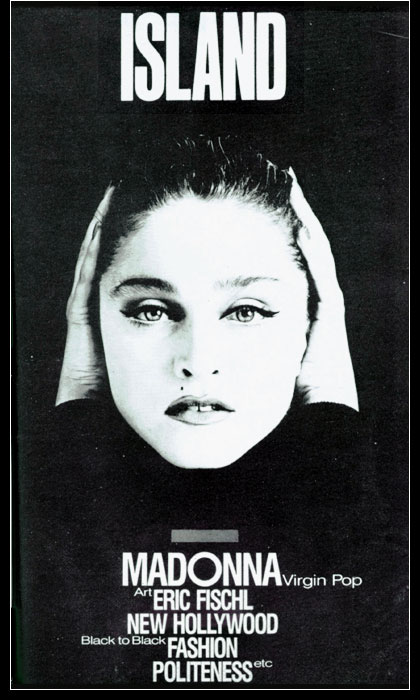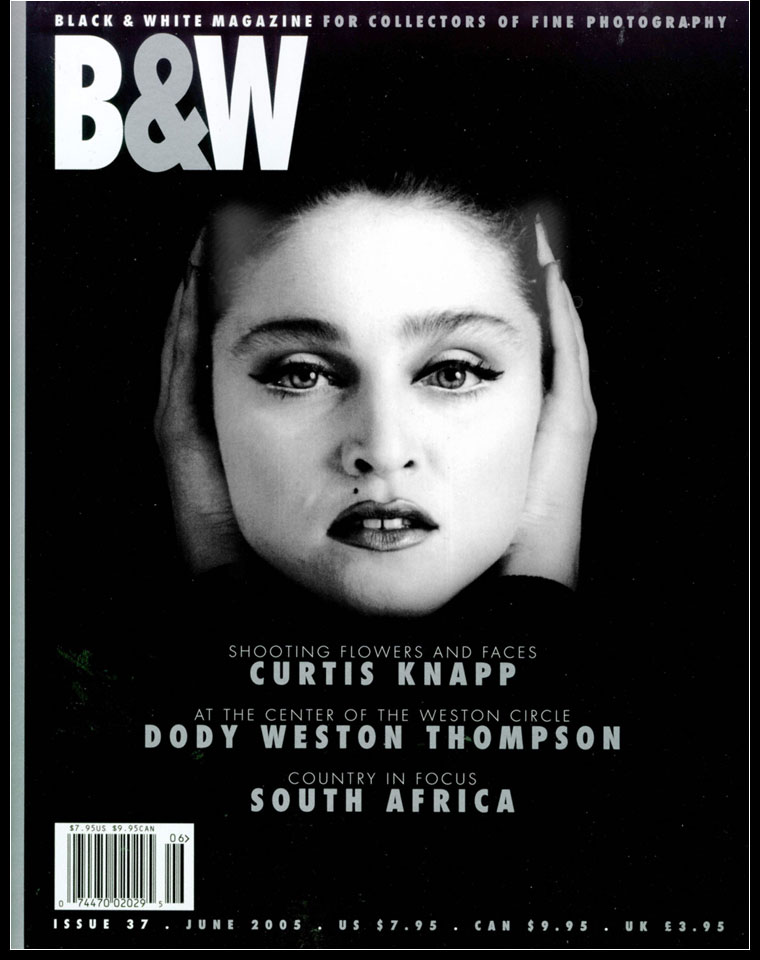| |
| |
| |
MadonnaTribe had the chance to talk to Curtis
Knapp, the award-winning portrait and fashion photographer
who has portraied some of the most influential musicians,
actors, writers, artists and celebrities of our times, including
Laurie Anderson, William Burroughs, Brian
Eno, Dennis Hopper, Lou Reed, and REM,
and signing the photoshoot for Madonna's first magazine
cover ever.
Back in new York City after spending two decades in Japan,
Curtis has recently been featured in two exhibitions about
Andy Warhol in Washington and New York City, showing
the portraits of Warhol he shot in 1983 that are
among the last images of the artist in his last Factory.
|
|
| |
MadonnaTribe: Hello Mr. Knapp and welcome
to MadonnaTribe. Madonna fans are most familiar with your
work for the amazing "early years" photo portraits
of Madonna. You happen to be the photographer of the first
magazine cover Madonna ever had back at the beginning of her
road to stardom.
But you started your career as a graphic designer and you
went on painting and doing illustrations in the '70s. When
did you discover that being a photographer was going to be
the job of your life?
Curtis Knapp: There was a transition somewhere
in the later '70s. I had been living in Athens GA. My friends,
The B52s needed photographs for some gigs. We took
some photos as I dabbled in it at the time. Later in NYC,
I photographed many Athens bands - Pylon, OH-OK, Love
Tractor and REM’s cover for CHRONIC
TOWN.
|
|
 |
MT:
As mentioned earlier, you are the photographer of Madonna's
first magazine cover ever, hundreds covers came after that
for her. But what does it feel to be the photographer of
that first cover, "Island" is a part of music
history now.
CK: I do not think just on Madonna. Perhaps someday
(I have been told) my archives will be or help in some small
way some sort of history on many of the people or subjects
in my files.
MT:
That number of Island is very rare now and
collectors from around the world are always looking for
a copy.
For those who have never had the chance to see a copy, what
kind of magazine was Island and how did they get in touch
with you to do the Madonna photo shoot?
CK:
Arnold and the staff planned it. And they where very
excited about it. And they did plan it around the time of
her First record (remember records?) release. They had parties
etc... She lived on the next block. She came over to the
‘Apartment’ to pick from my contact sheets.
My Daughter Rei-re just asked when she could use the living
room and watch TV. Ah kids.
MT: What do you recall of that young and
fresh Madonna on the set? did you feel she would have achieved
so much in the music business and become such an iconic
figure?
CK:
Honestly, she was very focused on her idea
of HER. But at that time, that day, we just had fun and
worked on taking good pics.
MT: How many
photos did you take that day? Just a few were published
and there must be many outtakes...
CK:
Yes and fans can contact me direct for gallery
prints, which I sell on my site. But between moving here
and there many negatives had gone by the wayside and lost.
MT: Recently
a slightly different pose of that photo appeared on the
cover of a special number of Black & White Magazine
for an interesting article. It was a great treat for fans
and magazine collector who don't own the original Island
cover.
Did you personally choose that outtake for that cover?
CK:
"Hands" are placed a bit different
and the balance is better. I also used on the book Goddess
(Italian version). It is my personal choice.
|
|
|
MT: Did you
shoot the Madonna session in Black and White? From what
we know it
requires a whole different lighting right?
CK:
I work mostly in B&W. I did shoot some
color.
MT: What do you
think is the quality you have that makes your photos unique?
CK:
Simple is best. Focus on the face / person.
Not the cloths or the background. But that is different
thinking when I shoot for advertising or products. Simple
was my main thing when I taught at the Smithsonian Institute
in DC a few years back.
MT: In your years
shooting for magazines such as Interview and Esquire
you went on photographing other rock and pop stars
and actors. Which was the most easy person to work with
and the most difficult?
CK:
To answer that, who would I end up offending
someone? I usually shoot (for my personal shootings) only
two or four rolls of film. If one does not get it in the
first rolls, they are looking for that exposure called in
Japan "Lucky Hit". That's not photography.
In dealing with sitters, I always would rush over to them
and try and befriend them... can I get you tea, have seat
etc...
Irving Penn told me, "stop that. Let the assistant
or editor do that. Stay aloof and make a space between you
and the sitter. It leads to a better connection later on
the set". It took a few years for me to see what he
meant. It is like, 40 can’t tell 20 what 40 is like
till 20 becomes 40?!
Never been set off. One day Jim Carroll (for whom I did
a record cover and had photographed three or four times),
brought Lou Reed to the studio. I was nervous. And why?
I don't know why.
MT: When we have a chance to meet photographers
that have worked with Madonna in the early stage of her
career we like to ask them how would they photograph her
today. So what setting, what ideas would you like to try
in a ipotetich new Madonna shoot?
CK:
I think one of these day she and I might re-create
that image again. It would not be the same with another
photographer. But note MY black turtle neck has been on
a lot of people before and since.
MT: In 1984 you
moved from New York to Japan. Why did you take this decision?
There are huge differences among the two cultures...
CK:
That is a huge Q. And the answer could fill
a book. It was time for my Daughter Rei-re to start First
grade in Tokyo.
MT: Working in Japan you also focused on
local artist. What's the difference between working with
American artists and Japanese ones?
CK: In America / NYC, people just come
over to my studio. [I can remember Madonna shoot ending
late and all of us walking down the back dark stairway to
exit the building]. Where as Japan is a rental studio system
and the sitter (talent) shows up with managers, make-up
etc... It's just their style and it works there. Here
I like it when I can say 75% of my portraits are private
for my art.
In Japan they use the word "Talent-to" to discribe
an actor or musician etc... Which does not mean they are
talented in many cases. And that is not to say many people
really do have talent. Such as Ryu Murakami, Yoko-o Tadanori,
Toshiro Mifune (the real 7th Samurai). I have many stories
about Japan. Some good some bad some funny. My world there
was a Japanese one and not very Foreigner connected at all.
In a word "I love it there". Toki-doki sami-shi,
for Japan
MT: You recently went back living in the
USA, did you find the country changed since you left for
Japan?
CK: WOW! Of course. I was frozen in time
(I feel like). Used to be I could go up town, walk in, go
to a friends office. Now days you get searched at the front
door, cameras in the elevators, reception desk on that floor
you get out on... Everyone is excepting this paranoia. Along
with moving so fast in the electronic world... Humanism
is completely gone. It's very sad. But people are wonderful
and I love photographing them.
MT: Mr. Knapp, thanks for sharing your
time with us. All the best for everything coming up!
|
|
 |
| |
For
more info about Curtis Knapp, his biography,
his amazing images and prints please visit
www.curtisknapp.com
Madonna
portraits by Curtis Knapp, on the cover of Island and
Black & White Magazine - all rights
reserved.
This interview © 2007 Madonna Tribe. |
|
 Your favourite stop for latest Madonna
news, previews, articles, exclusive interviews, magazine and
cover scans,
Your favourite stop for latest Madonna
news, previews, articles, exclusive interviews, magazine and
cover scans,
picture galleries, and Community Forum. This site is not endorsed
by Madonna or Warner Bros Records.
From fans to fans, © 2003-2007 Madonna Tribe
|
|
 |
|
|
